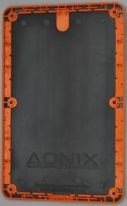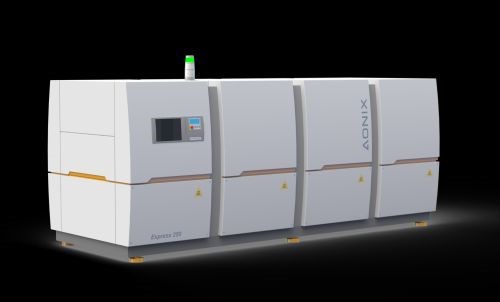Aonix Advanced Materials system combines material, machinery
Ottawa-based company develops turnkey technology for high-performance, thermoplastic composites at volumes of up to 1 million parts per month.

Aonix tablet chassis made with carbon fiber, Ultra-S matrix and Express machine.
Aonix Advanced Materials (Ottawa, Ontario, Canada) showed off what its technology can produce at JEC 2014 (March 11-13, Paris, France). An ultrathin (0.7mm/0.028-inch), tablet computer chassis (also called a unibody or back plate plus edge frame), made from 11 plies of unidirectional carbon fiber molded into a thermoplastic composite based on Aonix’ Ultra-S (sulfone-based) matrix material using an Aonix Express molding machine is 50 percent thinner and 65 percent lighter than a typical aluminum version. It can also be produced in volumes as high as one million parts per month. Oh, and the edge frame (shown in orange) can be overmolded onto the chassis within the same equipment. The company received significant interest from Airbus and many other composites users during the JEC expo and looks forward to a wide variety of development programs as a result.
Aonix was founded by president and CEO, Jerome Le Corvec, in 2008. After working with composites for many years, Le Corvec was frustrated with the high labor cost and slow manufacturing processes in the industry. He envisioned the capability to produce high performance composites with the speed and complex molding of plastic injection. However, he found that most injection machines were not designed for the materials being used and most materials were not designed for the final part properties desired. Thus, Aonix has developed a four-pronged approach that delivers to its customers a complete turnkey system for producing high performance composites: (1) Aonix UltraMaterials, (2) Express high capacity molding machines, (3) guaranteed, on-time supply of UltraMaterials blanks, and (4) an integrated 24-7 remote-monitoring and predictive maintenance system.
With the UltraMaterials product line, LeCorvec sought to enable injection molding of ultra high performance composites that would demonstrate a true cost and performance advantage over epoxy, the conventional matrix base for most composites. The UltraMaterials Solution includes the Ultra-P, Ultra-S and Ultra-I families of polymers, based on modified paraphenylene, sulfone and polyimide systems, respectively, each family having up to four variants. Composites made with Ultra-I matrix systems (modified polyimide) show thermo-mechanical properties that are comparable to PEEK-based composites, while those using Ultra-S matrix systems (modified sulfone) compete head-to-head with conventional epoxy-based composites. However, all of the systems are amorphous, which is key for quick processing. Le Corvec recalls, “In the beginning of thermoplastic composites, it was perceived that crystalline polymers always have better properties, while amorphous systems, like nylon, always have lower properties. This is no longer the case.” He knew crystalline systems were not the way to go because of their issues with very sensitive and long cooling cycles in order to form critical crystalline structure and avoid warpage in the final part. Thus, Aonix UltraMaterials were inherently designed to be molded quickly and also to be compatible with overmolding using a wide range of polymers.
Aonix announced recently that Solvay Specialty Polymers (Brussels, Belgium) has acquired a minority stake in the company. Le Corvec comments that Solvay has the largest portfolio of thermoplastic polymers and also a complimentary selection to Aonix’ own materials. “Our partnership with Solvay opens many doors with overmolding,” relates Le Corvec, “but which materials are used in a given project are determined by our customers, some of which have to meet specifications which mandate a specific materials supplier. A specification requires BASF? No problem. We also have superb material systems, but our focus must be on what the customer needs for their specific part because our objective is to provide a solution, not just a material.”
The stages of Aonix solution development begin with Design and Prototyping. “Our customers are the parts expert, so they will tell us what they need to make,” explains Le Corvec. “We are the materials and process experts, so we will develop the materials and machinery combination to meet their specific requirements.” In the next stage, Aonix will build the custom-tailored production equipment, followed by extensive pre-production testing where both materials and machines can be tweaked if needed. Finally, the machines will be transferred to the customer location, put through post-installation prove-out and Aonix supply of blanks will be established. When asked if manufacturers will have to completely retool in order to take advantage of Aonix’ technology, Le Corvec replies, “They could probably re-use robotic elements and also injection machines for overmolding.” He notes that Aonix Solution technology extends traditional thermoplastic molding capability to include sandwich structure, for example, and welding of outer Class A shells to inner structural shells.

Example of Aonix' Express molding machines.
As far as the process, Le Corvec says that it is close to stamping, but highly optimized and fully automated. Unlike conventional open presses, in which technicians place material, operate the press and remove the material, all the while trying to troubleshoot forming and molding issues, the Express machines are completely enclosed and designed on a per-case basis to repeatedly produce high-quality parts to customer specifications. “The process must be reliable regardless of the operator,” says Le Corvec. “This is key to decreasing the labor cost per part and bringing manufacturing back to North America.”
Le Corvec says Aonix is looking at electronics and electrical applications (e.g., laptop and tablet chassis) for near-term (1 to 3 years) commercial applications requiring millions of parts/year, followed by more moderate volume, 3- to 7-year applications in automotive, and then long-term aerospace applications which require at least 7 to 10 years before qualification and commercial adoption. For automotive, he notes that Aonix solutions are well-suited as a lightweight replacement for metal parts but also to replace other thermoplastics where no good solution has yet been found to work consistently. “Our competition is not what isn’t broken, but instead solving what currently does not work,” Le Corvec explains, “We have a good tool box that we are using to help customers achieve solutions that work for them.”
Related Content
Plant tour: Joby Aviation, Marina, Calif., U.S.
As the advanced air mobility market begins to take shape, market leader Joby Aviation works to industrialize composites manufacturing for its first-generation, composites-intensive, all-electric air taxi.
Read MorePlant tour: Albany Engineered Composites, Rochester, N.H., U.S.
Efficient, high-quality, well-controlled composites manufacturing at volume is the mantra for this 3D weaving specialist.
Read MoreInfinite Composites: Type V tanks for space, hydrogen, automotive and more
After a decade of proving its linerless, weight-saving composite tanks with NASA and more than 30 aerospace companies, this CryoSphere pioneer is scaling for growth in commercial space and sustainable transportation on Earth.
Read MorePEEK vs. PEKK vs. PAEK and continuous compression molding
Suppliers of thermoplastics and carbon fiber chime in regarding PEEK vs. PEKK, and now PAEK, as well as in-situ consolidation — the supply chain for thermoplastic tape composites continues to evolve.
Read MoreRead Next
Modeling and characterization of crushable composite structures
How the predictive tool “CZone” is applied to simulate the axial crushing response of composites, providing valuable insights into their use for motorsport applications.
Read MoreCFRP planing head: 50% less mass, 1.5 times faster rotation
Novel, modular design minimizes weight for high-precision cutting tools with faster production speeds.
Read More“Structured air” TPS safeguards composite structures
Powered by an 85% air/15% pure polyimide aerogel, Blueshift’s novel material system protects structures during transient thermal events from -200°C to beyond 2400°C for rockets, battery boxes and more.
Read More






















